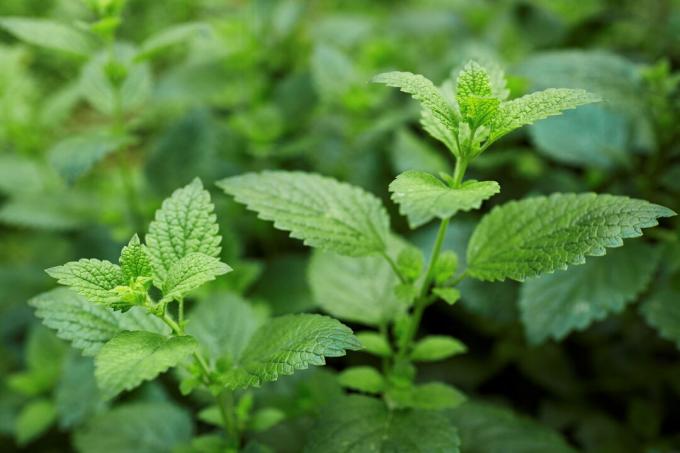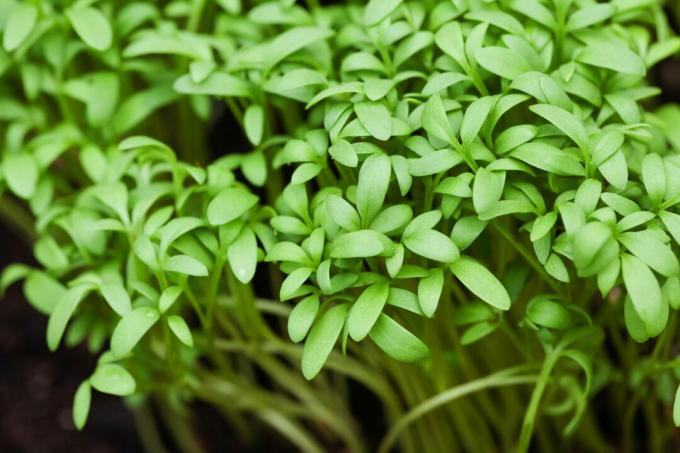Not all herbs get along well with each other. We have summarized in a large table which herbs go together and which do not.

There are countless herbs that are worth growing yourself in the garden. These come from the most diverse regions of the world and would probably never all meet without our help. So, just like in real life, there are some who get along great and others who are best kept at a distance. But which herbs go together? We provide tips and information on how best to structure your herb bed. Mixed cultures of herbs can definitely have positive effects, because herbs can have a positive effect on each other.
These herbs go together
Many factors are decisive for a good neighborly relationship:
- Similar location claims: Herbs with similar demands on their environment - such as solar radiation, soil and nutrients - have the best prerequisites for good neighborliness. Herb soils like ours Organic herbal & seed soil from Plantura are adapted to the needs of many herbs and thus make their contribution to good neighborliness.
- Growth: If two herbs grow at about the same rate, there is no risk that one will overgrow the other. In this way, both herbs can thrive side by side without displacing each other.
- Ingredients: Do you love rosemary? You are not alone, Basilikum totally agrees with you. The intense scent of herbs already indicates that they are rich in ingredients. These also reach neighboring weeds through water, air or soil. In some cases, the components of one herb can positively affect the other in terms of growth, disease tolerance, or taste.

| herb | Suitable partners in the herb bed |
|---|---|
| rosemary (Rosmarinus officinalis), thyme (Thymus vulgaris), lavender (Lavandula), sage (Salvia officinalis), hyssop (Hyssopus officinalis), mountain savory (Satureja montana) | Get along well with each other due to similar demands on the location (sunny, warm, low in nutrients, alkaline pH value). |
| rosemary (Rosmarinus officinalis) | Rosemary promotes the growth of basil (Ocimum basilicum) |
| sage (Salvia) | Promotes the growth of oregano (Origanum vulgare) and savory (Satureja) |
| thyme (Thymus vulgaris) | Goes well with fennel (Foeniculum vulgare), coriander (Coriandrum sativum), tarragon (Artemisia dracunculus), borage (Borago officinalis) and Mediterranean herbs (see above) |
| chamomile (Matricaria chamomilla) | Promotes the growth of dill (Anethum graveolens), chives (Allium schoenoprasum), marjoram (Origanum majorana), chervil (Anthriscus cerefolium) and burnet (Sanguisorba minor) |
| Parsley (Petrosilium crispum ssp. crispum) | Goes well with chives (Allium schoenoprasum), basil (Ocimum basilicum), coriander (Coriandrum sativum), tarragon (Artemisia dracunculus), burnet (Sanguisorba minor) |
| hyssop (Hyssopus officinalis) | Promotes the growth of lavender and savory |
| basil (Ocimum basilicum) | Compatible with almost all herbs |
| lovage (Levisticum officinale) | Promotes the growth of fennel and parsley (Petroselinum crispum ssp. crispum) |
| borage (Borago officinalis) | Compatible with almost all herbs |
| lemon balm (Melissa officinalis) | Compatible with almost all herbs |
These herbs don't get along
There are several reasons why some herbs may not like each other:
- Annual and perennial herbs: In principle, annual and perennial herbs get along with each other, but the perennial herb will severely disturbed when its year-old neighbor is dug up and replaced by a new one every year will.
- Location requirements: Mediterranean herbs love the sun, nutrient-poor and basic soil and like it a little drier. Lemon balm and mint enjoy a slightly more shady and nutrient-rich location. So it is logical that the two groups cannot grow so close together.
- Competitor: Some herbs are very fast-growing and would simply crowd out slow-growing species. You should therefore keep such species at a distance.
- Ingredients: Herbs are rich in essential oils and other ingredients. That's why we value them so much. However, not every herb tolerates the substances that its neighbor produces. Such cases can lead to stunted growth or even the death of the plant. For this reason, garden cress, for example, is rather unpopular as a neighbor for many plants.

If you take these principles into account, you can find out many good and bad variants yourself if you find out about location requirements and growth behavior. Nevertheless, we have put together a table for you with herbs that do not get along at all.
| herb | Doesn't get along |
|---|---|
| dill (Anethum graveolens) | cress (Lepidium sativum), fennel (Foeniculum vulgare), Caraway seed (Carum carvi), tarragon (Artemisia dracunculus) |
| basil (Ocimum basilicum) | lemon balm (Melissa officinalis), mint (mentha) |
| Parsley (Petroselinum crispum ssp. crispum) | chervil (anthriscus), dill (Anethum graveolens) |
| lemon balm (Melissa officinalis) | basil (Ocimum basilicum) |
| fennel (Foeniculum vulgare) | coriander (Coriandrum sativum), dill (Anethum graveolens), cress (Lepidium sativum), marjoram (Origanum majorana), Caraway seed (Carum carvi) |
| peppermint (Mentha x piperita) | chamomile (Matricaria chamomilla) |
| garden cress (Lepidium sativum) | dill (Anethum graveolens), fennel (Foeniculum vulgare), coriander (Coriandrum sativum), Parsley (Petroselinum crispum ssp. crispum), Arugula (Eruca vesicaria), chervil (anthriscus) |
| marjoram (Origanum majorana) | fennel (Foeniculum vulgare), thyme (thymus) |
| thyme (thymus) | marjoram (Origanum majorana) |
A good way to keep herbs that don't get along so well in a small space is to plant one herbal spiral. Here you can create wet and dry, lean and nutrient-rich micro-zones.
So that your herbs can unfold their full aroma, they should be fertilized from time to time. You can find out all about it in our special article fertilizing herbs. You can also get an overview of here immune-boosting herbs receive.



